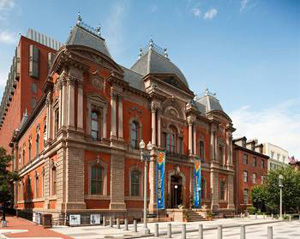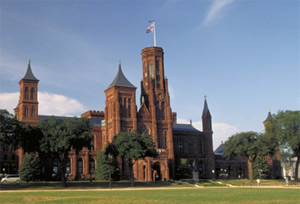- Home
- About
- About SCMS
- Directors
- Artists
- Vera Beths
- Steven Dann
- Marc Destrubé
- James Dunham
- Mark Fewer
- Eric Hoeprich
- Christopher Krueger
- Myron Lutzke
- Marilyn McDonald
- Douglas McNabney
- Mitzi Meyerson
- Pedja Muzijevic
- Anca Nicolau
- Jacques Ogg
- Loretta O'Sullivan
- Lambert Orkis
- Paolo Pandolfo
- William Purvis
- Marc Schachman
- Jaap Schröder
- Andrew Schwartz
- William Sharp
- Ian Swensen
- Lucy van Dael
- Ensembles
- Concerts
- The Collection
- Recordings
- Education
- Donate
Music Hall, National Museum of American History
 The Music Hall came into being as part of the 2013-2015 renovation of the west wing of the National Museum of American History. It will serve as the anchor for NMAH's culture and the arts exhibits when they open in 2020 on the Museum's third floor. The Music Hall replaces the former Hall of Musical Instruments, or HMI, which was “home base” for the Smithsonian Chamber Music Society since its inception, acting as its primary rehearsal location, the venue for most SCMS concerts involving keyboard instruments from the Smithsonian collection, and workshop space for SCMS educational activities involving visiting student and scholars. Formerly located on the west end of the third floor of the National Museum of American History, its broad windows commanded an impressive view of the National Mall from the Washington Monument to the Lincoln Memorial. The Music Hall's new configuration, with the stage at its west end in front of the windows, includes flexible seating designed to accommodate a wide variety of performers' positioning while insuring that each audience member enjoys an intimate listening experience.
The Music Hall came into being as part of the 2013-2015 renovation of the west wing of the National Museum of American History. It will serve as the anchor for NMAH's culture and the arts exhibits when they open in 2020 on the Museum's third floor. The Music Hall replaces the former Hall of Musical Instruments, or HMI, which was “home base” for the Smithsonian Chamber Music Society since its inception, acting as its primary rehearsal location, the venue for most SCMS concerts involving keyboard instruments from the Smithsonian collection, and workshop space for SCMS educational activities involving visiting student and scholars. Formerly located on the west end of the third floor of the National Museum of American History, its broad windows commanded an impressive view of the National Mall from the Washington Monument to the Lincoln Memorial. The Music Hall's new configuration, with the stage at its west end in front of the windows, includes flexible seating designed to accommodate a wide variety of performers' positioning while insuring that each audience member enjoys an intimate listening experience.
Constitution Ave. NW between 12th and 14th Streets
Washington, D.C. 20500
Map & Directions
METRO:
Federal Triangle or Smithsonian (Orange/Blue line)
Metro Center (Red line)
Street parking may be available.
Renwick Gallery
 The Smithsonian’s Renwick Gallery of American Art was designed by the noted architect James Renwick Jr. (who also designed the Smithsonian's Castle and St. Patrick's Cathedral in New York City) as Washington DC's first art museum. The building, completed in 1861, is in the French Second Empire Style and the Grand Salon, where the Smithsonian Chamber Music Society performs, is modeled on one of the galleries of the Louvre. The Salon's warm acoustics and soaring forty-foot ceiling make it a perfect venue for chamber music and chamber orchestra performances.
The Smithsonian’s Renwick Gallery of American Art was designed by the noted architect James Renwick Jr. (who also designed the Smithsonian's Castle and St. Patrick's Cathedral in New York City) as Washington DC's first art museum. The building, completed in 1861, is in the French Second Empire Style and the Grand Salon, where the Smithsonian Chamber Music Society performs, is modeled on one of the galleries of the Louvre. The Salon's warm acoustics and soaring forty-foot ceiling make it a perfect venue for chamber music and chamber orchestra performances.
1661 Pennsylvania Avenue N.W. (at 17th Street)
Washington, D.C. 20500
Map & Directions
METRO:
Farragut West (Orange/Blue line)
Farragut North (Red line)
Street parking may be available.
Castle Commons
Completed in 1855, the original Smithsonian Institution Building—known familiarly as “The Castle”—was, like the Renwick Gallery, designed by architect James Renwick Jr. The Washington landmark was constructed of red sandstone in the Norman style, a twelvth-century combination of late Romanesque and early Gothic motifs. The magnificent room known as the Commons, which thrusts its lofty vaulted-ceiling mass out from the west end of the Castle’s central core, was the original library for  the Smithsonian Institution, one of the major American research libraries in the nineteenth century.
the Smithsonian Institution, one of the major American research libraries in the nineteenth century.
1000 Jefferson Drive SW (on the south side of the National Mall)
Washington, D.C. 20560
Map & Directions
METRO:
Smithsonian (Orange/Blue line)
L’Enfant Plaza (Yellow/Green line)
Street parking may be available.


